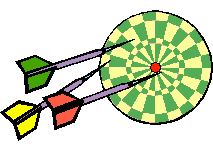25
Dxing Tips For The Little Guy
BY BRIAN D. SMITH, WO9I
![]()
Are you a little guy? No, not QRPer. A little guy, one of the legions who venture into the ether like armorless knights in search of DX dragons. Restricted by tight budgets and/or logistical problems (apartement living and the like), we run into pile-ups barefoot, brandishing our flimsy wire antennas---and more often than not, emerged bruised, battered, and empty handed.
Nay, dragon slaying seems to be the exclusive domain of our stouter rivals, who can spew kilowatts from their lofty, rotatable towers and crush our puny signals like so many ants beneath their boot heels. For us little guys, the DX Century Club certificate is aptly named because it seemingly takes about a century to earn.
It doesn't have to, however. I'm a life long little guy: I've never used anything better than aged tube rigs and wire antennas, and I've never operated from anywhere except Indiana (located in what DXers call "The Black Hole"). Yet I have one of those little DXCC sheepskins in my shack too, and honest to Hiram, I nabbed it in far less than 100 years. Does that make me a DXpert? Hardly. The Callbook bulges with ops who've forgotten more about DX than I'll ever know---but that's not the point.
The bottom line is that if I can make DXCC, practically any of you can do likewise. I'll address the rest of my comments to fellow little guys (and inexperienced DXers who always wanted to work the world). You big guys go play in the pile-ups.

Here are 25 DXing tips design for small-fry DXers. Happy dragon hunting!
Sharpen your sword. Never embark on a DX quest without first tuning-up your rig. Sometimes you get exactly one shot at a rare station before the rest of the world catches up with you.
Read the signs. Before starting the hunt, check band conditions to see if it's worth the effort. WWV (at 5, 10, 15 and 20 MHz) gives propagation info at 18 minutes past every hour. Also, 10 meter beacons around the world operate between 28.200 and 28.300 MHz; listen and learn what part of the world is coming in. Finally, tune around and check the IDs in on going QSOs. They'll tell you whether someone in your region is working Soviet Georgia or Atlanta, Georgia.
Never send "CQ DX." Rare DX station seldom answer such calls, especially when transmitted by weak signals. Unless you need a QSL from England or Germany, don't bother.
Take the 'tests. If I could operate only a few days a year, I'd pick the weekends of the major international contests such as the CQ World-Wide, the ARRL DX Contest, CQ WPX, and so forth. Ignore your score; the idea is to bag scarce DX, and these events are a little guy's Disneyland---bands crawling with rare stations, short QSOs, and best of all, wide dispersement of the heavy hitters, who are usually mounting their own contest efforts. Don't neglect the lesser known contests. For example, the Soviet Union's CQM brings out many of that nation's seldom-heard sections (UH, UI, UM, etc.).
Don't touch that dial. When a contest ends, call it quits, right? Wrong! Rare stations---particulary DXpeditions---sometimes hang around to see if anyone else wants to work them. The big guns are usually in their holsters by then, which is exactly why you're still blazing away.
Stroll the alleys. Peek into the DX alleys, which are usually located just inside the General band (14.026 Mhz, etc.). On non-contest days many rare stations hang out here. However, these are also the most congested places of all. But hey, sometimes the propagation gods smile on you.
Know when to say when. Don't spend your life trying to break pile-ups; when the band's open, there's plenty of good stuff elsewhere (usually from the same region), and lots of big guys don't know how to root it out. How to tell good odds from bad? Good odds: the DX station is booming, the op is working stations quickly, other station from your call area are getting through, and/or you don't hear much competition. Bad odds: weak DX station, slow op, propagation favours other call areas, pile-up is loud and limitless.
Nail the newcomers. Now for real guerilla tactics: Move to the slow edge of a band and, tuning slowly accross it, listen for the sound of any station coming on the air, such as a "tuning up" signal, "QRL?" or of course, CQ. Should one of these surface, stop immediately and listen for an ID. (Ninty-nine times out of 100 it wont be rare DX, but trust me: that 100th time will more than make up for it.)
Late means wait. As you're hunting stations coming on frequency, also check for QSOs that are about to end ("73,""TNX FER QSO," etc.)---and wait for an ID.
Develop DX ears. DX signals rarely sound like statesiders. They're weaker and more unstable (and those which cross over the North Pole sound "fluttery"). Teach your eardrums the difference.
Hang ten. Ten meters is the little guy's equalizer. When the surf's up on 10, the DX comes in waves, and a puny signal (even a 5 watter) floats just fine. Ten meters tend to open to a small geographic area at a time (meaning less competition); also, signal strength can fluctuate wildly within a few minutes. If you find a new one that's too weak to work, lock on to it and relax. Within 15 minutes its signal may peak, giving you a clear shot.
WFWL (work first worry later). If an exotic-sounding station appears, don't look up its QTH---pounch! I once heard a 3B8 sending CQ. "What's a 3B8?" I wondered, but the second he stopped transmitting, I chased him. Only after the QSO did I discover I had just worked Mauritius.
Rehearse. Rare DX stations are sometimes barely audible, or covered with QRM. A trained ear can pull them through, but an untrained ear hears only clutter. So hone your hearing. Practice working common DX stations (such as G's and JA's) with faint signals.
Upgrade. Much of the delectable DX swims in the extra portion of the band. Thus reeling it in is often a question of "How low can you go?" Remember, only 7 percent of all American amateurs can operate in these murky depths.
Rock around the clock. DX conditions vary with the time of day, so don't just operate from 7 to 9 o'clock every evening. Vary your routine: Stay up all night on a Friday, rise before down on a Sunday. Remember, sunrise and sunset can produce interesting conditions, so try them often.
Turn lemons into lemonade. "Bad breaks" aren't always what they seem. Sometimes they even work to the little guy's advantage. Example 1: While trying to work a weak ZK1 (South Cook Islands) during a contest. I was dismayed when a loud Californian began blasting away on a nearby frequency. Then I realized that because of the W6, most people who were casually tuning around wouldn't hear the ZK. During brief lull I caught his "QRZ?", jumped in, and nailed him instantly. Example 2: A T3Ø (West Kiribati) operating SSB dodged a stateside pile-up by QSYing to a U.S. CW-only frequency. Just one American moved with him---yours truly, who fired up a key and worked him cross-mode.
Talk the talk. Even with Q signals, all CW stations don't sound the same. DX stations favor expressions such as "TKS" (instead of American "TNX") and "DR" (as in "DR OM BRIAN"). Soviets often close with "DSW" (a Russian good-luck term). And of course, stations whose transmissions alternate between "599 K" and "QRZ?" are often worth working. Familiarity with international callsigns helps, too, as I learned one evening in 1988 when I tuned in Y88POL. Just another East German, right? But wait! East German suffixes usually have only two letters ... hmmm. Moments later I worked a new one---Antartica.
Less is Morse. Not only CW is less popular than SSB (decreasing your competition), but it's more effective in marginal conditions---a plus for weak stations.
Read the news. Serious operators learn about DXpeditions and such by subscribing to publications such as QRZ DX? and The DX Bulletin. And for those with packet capability, lots of DX packet clusters spot rare stations.
Never assume. Once, during a Boy Scout jamboree weekend, I heard a Liberian station with a special callsign, using scouts as ops. No one was answering its CQ, probably because everyone believed the station was working only fellow Scouts. But when I asked, "Are you working only Scout stations?" I was rewarded with a "No, you're 5 by 6"---and a new one.
Beat the bushes. Many people think all the primo DX hangs out on the low ends, but that's a fallacy. Ever work Moroco? I did---on a 10 meter Novice CW frequency! And I once heard Zimbabwe on 21.080. Moral: Don't just look in the clearings; rummage through the high weeds, too.
Listen for swan songs. Normally, when sunspots are high, upper HF bands such as 10 and 15 meters close in the evening. During their final moments, however, strange conditions sometimes occur. Try to catch each band just before it gives out (see whether any signals are audible; if so, tune around). As the band dies, most of your competition will give up and head south. I bagged my first CEØ (Easter Island) under such conditions.
Check and double check. Don't just scribble down a DX callsign; make absolutely certain you heard it correctly. On CW I've worked lots of ops who can't tell a "4" from a "V" or an "H" from an "S." Missing even one dot in a call sign can turn a prize catch into the one that got away.
Nab 'em in the net. DX nets are groups of ham who meet regulary (check DX publications for details) and allow participants to take turns trying to work the rare ones on frequency. Purist pooh-pooh the practice, but all's fair in love and DX.
QSL religiously. Send a card after every DX QSO: via the bureau, direct or direct with SASE. Direct QSLs with SASEs aren't cheap (generally $1 per card, plus your own 50¢ airmail postage); then again, if you QSLed your first 100 countries this way, you'd end up spending $150---hardly an exorbitant sum. My advice: QSL the common station VIA BURO and shell out a few bucks for the tough stuff. To me, that's just part of the cost of entertainment---same as golf balls and fishing worms.
![]()
For the big guns who are still in the audience (I knew you wouldn't leave). I'd like to close with two humble requests:
When you hear a pile-up caused by a DX station you don't need, resist the urge to work it again. (And please, none of this, "Hello, Abdul, I worked you last night and you're still sounding good here" or "Just got your QSL card---thanks" stuff.) We're impressed with your signal, but how about giving the rest of us a chance for new one?
When a station is working QSOs contest-style ("599 K"), don't tell him your life story. To my chagrin, I've even heard ops with old-style U.S. call signs respond to a "599" with "R R TNX UR 599 599 IN DALLAS OP GEORGE GEORGE 73 K." Please, just send "TU 599 K" and save everything else for the ragchews.
Finally for the DX stations who handle pile-ups by taking one call area at a time, we little guys thank you. But once in a while, how about starting with the Ø's and working backward.
